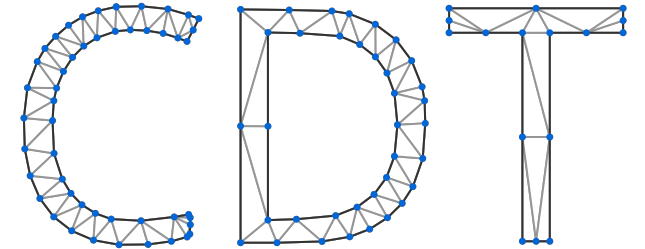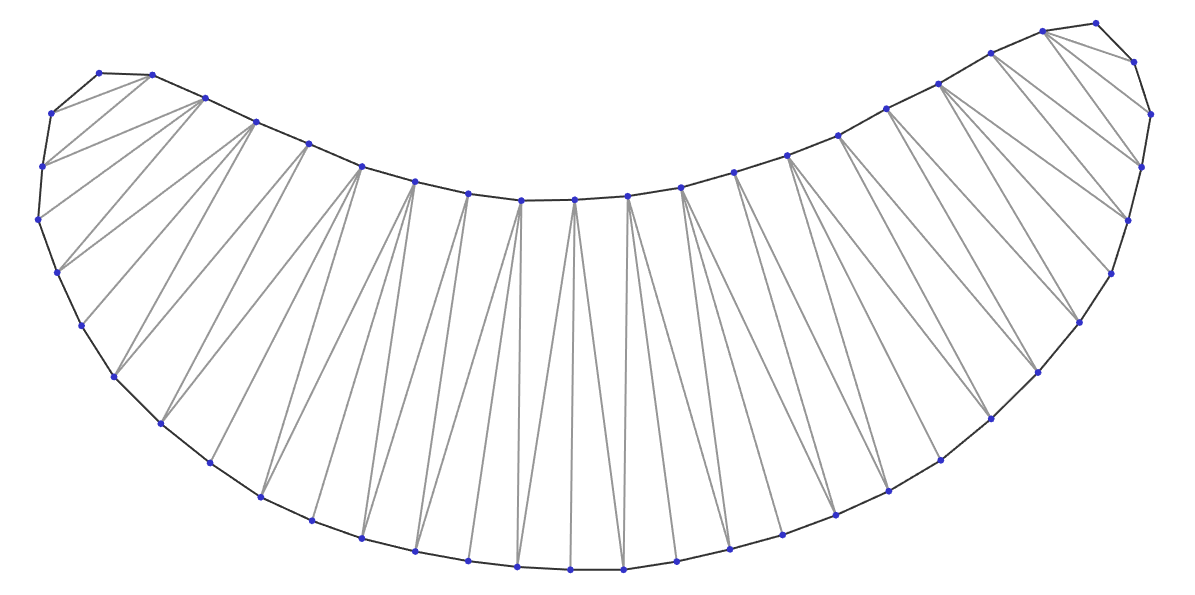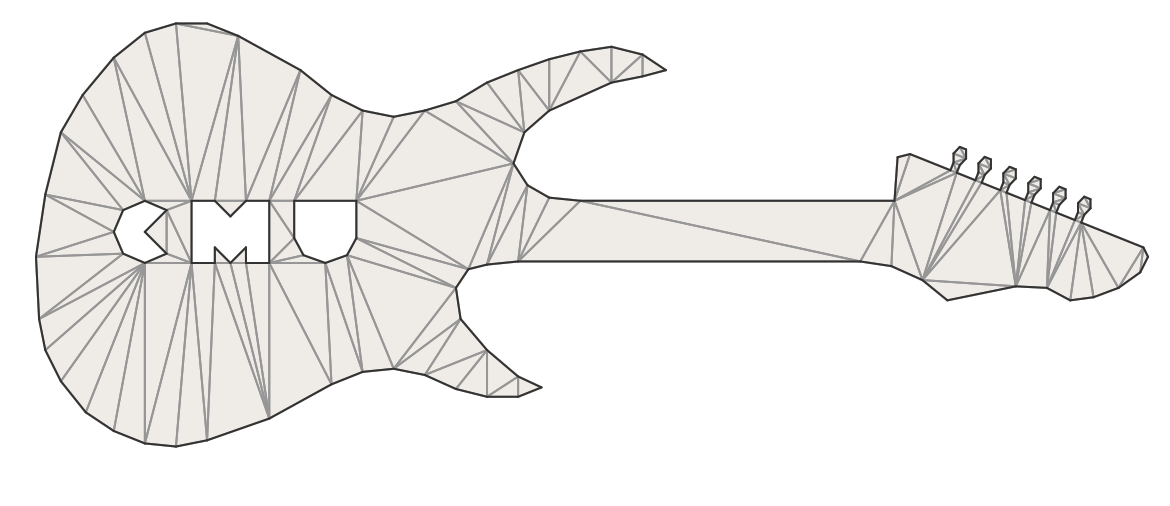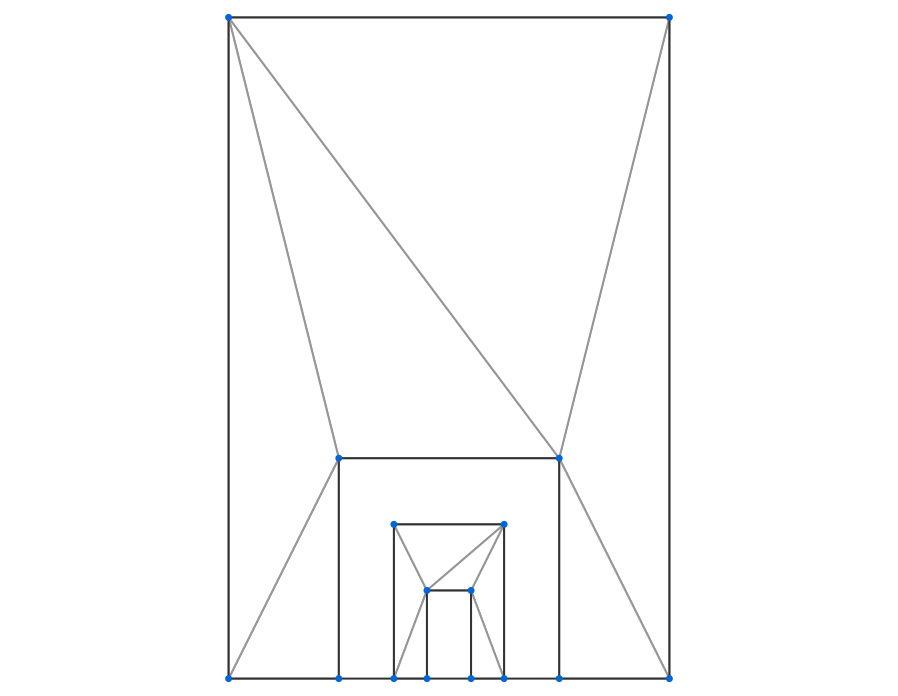CDT is a C++ library for generating constraint or conforming Delaunay triangulations.
- open-source: permissively-licensed under Mozilla Public License (MPL) 2.0
- cross-platform: tested on Windows, Linux (Ubuntu), and macOS
- portable: backwards-compatible with C++98
- bloat-free: no external dependencies by default
- flexible: can be consumed as a header-only or as a compiled library
- performant: continuously profiled, measured, and optimized
- numerically robust: triangulation algorithms rely on robust geometric predicates
If CDT helped you please consider adding a star to on GitHub. This means a lot to the authors 🤩
Table of Contents
- Overview
What can CDT do?

- Constrained Delaunay Triangulations: force edges into Delaunay triangulation
- Conforming Delaunay Triangulations: add new points into Delaunay triangulation until the edge is present in triangulation
- Convex-hulls
- Automatically finding and removing holes
Properly Handling the Corner-Cases

- Points exactly on the edges
- Exactly overlapping edges
- Resolving intersecting edges by adding points at the intersections (with
CDT::IntersectingConstraintEdges::Resolve)
Online Documentation
Latest online documentation (automatically generated with Doxygen).
Algorithm
- Implementation closely follows incremental construction algorithm by Anglada [1].
- During the legalization, the cases when at least one vertex belongs to super-triangle are resolved using an approach as described in Žalik et. al [2].
- For finding a triangle that contains inserted point remembering randomized triangle walk is used [3]. To find the starting triangle for the walk the nearest point is found using a kd-tree with mid-split nodes.
- Order in which vertices are inserted is controlled by
CDT::VertexInsertionOrder:CDT::VertexInsertionOrder::Autouses breadth-first traversal of a Kd-tree for initial bulk-load [4] and randomized insertion order for the subsequent calls ofCDT::Triangulation::insertVertices. Randomization improves performance and avoid worst-case scenarios. Generally vertex insertion withCDT::VertexInsertionOrder::Autois faster.- The original vertices order can be optied-in using
CDT::VertexInsertionOrder::AsProvidedwhen constructing a triangulation.
Pre-conditions:
- No duplicated points (use provided functions for removing duplicate points and re-mapping edges)
- No two constraint edges intersect each other (overlapping boundaries are allowed)
Post-conditions:
- Triangles have counter-clockwise (CCW) winding
Implementation Details
- Supports three ways of removing outer triangles:
CDT::Triangulation::eraseSuperTriangle: produce a convex-hullCDT::Triangulation::eraseOuterTriangles: remove all outer triangles until a boundary defined by constraint edgesCDT::Triangulation::eraseOuterTrianglesAndHoles: remove outer triangles and automatically detected holes. Starts from super-triangle and traverses triangles until outer boundary. Triangles outside outer boundary will be removed. Then traversal continues until next boundary. Triangles between two boundaries will be kept. Traversal to next boundary continues (this time removing triangles). Stops when all triangles are traversed.
- Supports overlapping boundaries
- Removing duplicate points and re-mapping constraint edges can be done using functions:
CDT::RemoveDuplicatesAndRemapEdges,CDT::RemoveDuplicates,CDT::RemapEdges - Uses William C. Lenthe's implementation of robust orientation and in-circle geometric predicates: github.com/wlenthe/GeometricPredicates
- Boost is an optional (to opt-in define
CDT_USE_BOOST) dependency used for:- Fall back for standard library features missing in C++98 compilers.
- Minor performance tweaks:
boost::container::flat_setis used for faster triangle walking.
- A demonstrator tool is included: requires Qt for GUI. When running demo-tool make sure that working directory contains files from 'data' folder.
Installation/Building
CDT uses modern CMake and should just work out of the box without any suprises. The are many ways to consume CDT:
- copy headers and use as a header-only library
- add to CMake project directly with
add_subdirectory - pre-build and add to CMake project as a dependency with
find_package - consume as a Conan package
CMake options
| Option | Default value | Description |
|---|---|---|
| CDT_USE_BOOST | OFF | Use Boost as a fall-back for features missing in C++98 and performance tweaks (e.g., boost::flat_set) |
| CDT_USE_64_BIT_INDEX_TYPE | OFF | Use 64bits to store vertex/triangle index types. Otherwise 32bits are used (up to 4.2bn items) |
| CDT_USE_AS_COMPILED_LIBRARY | OFF | Instantiate templates for float and double and compiled into a library |
Adding to CMake project directly
Can be done with add_subdirectory command (e.g., see CDT visualizer's CMakeLists.txt).
Adding to non-CMake project directly
To use as header-only copy headers from CDT/include
To use as a compiled library define CDT_USE_AS_COMPILED_LIBRARY and compile CDT.cpp
Consume pre-build CDT in CMake project with find_package
CDT provides package config files that can be included by other projects to find and use it.
Consume as Conan package
There's a conanfile.py recipe provided. Note that it might need small adjustments like changing boost version to fit your needs.
Using
Public API is provided in two places:
CDT::Triangulationclass is used for performing constrained Delaunay triangulations.- Free functions in
CDT.hprovide some additional functionality for removing duplicates, re-mapping edges and triangle depth-peeling
Code Examples
Delaunay triangulation without constraints (triangulated convex-hull)
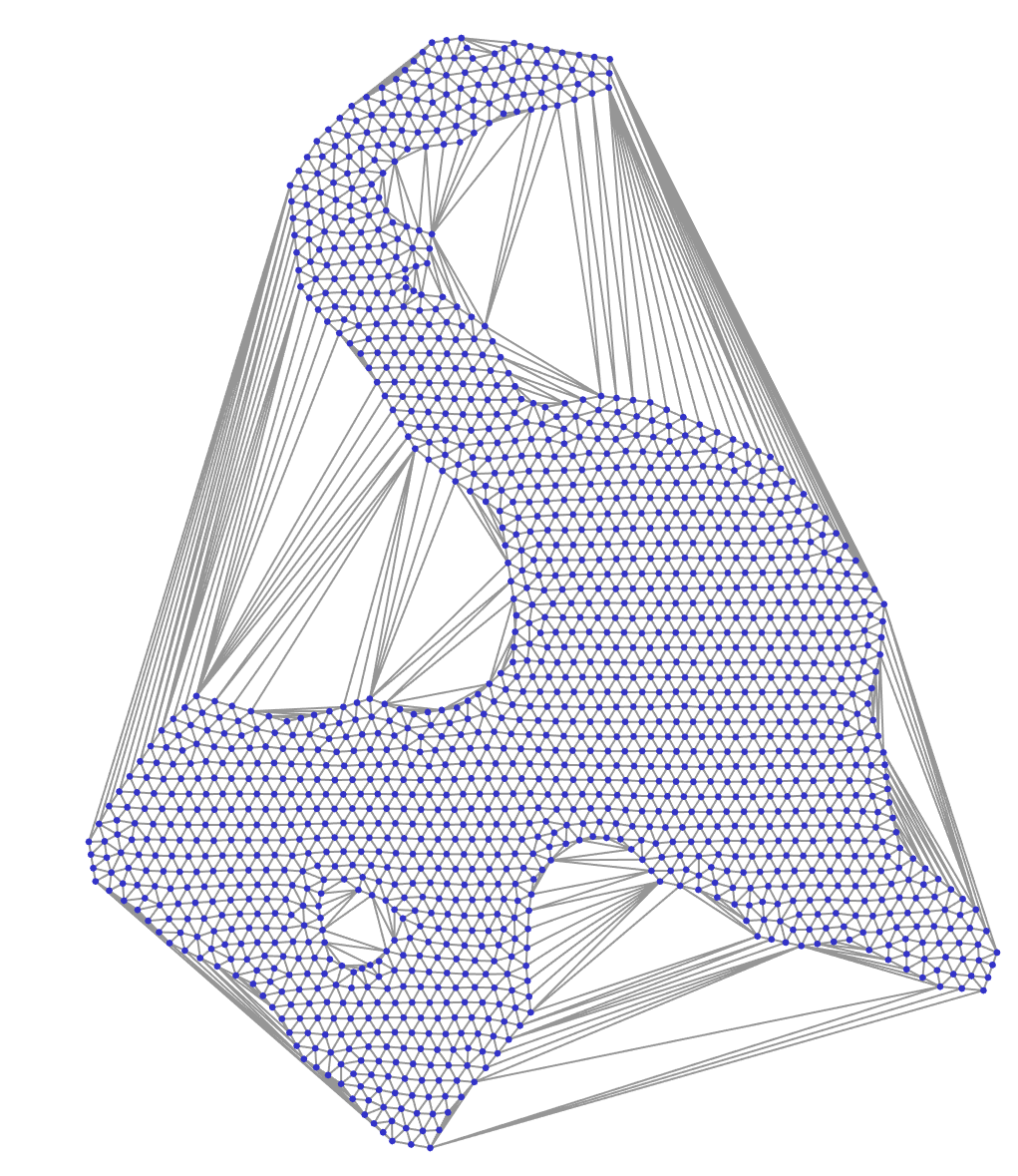
Constrained Delaunay triangulation (auto-detected boundaries and holes)

Conforming Delaunay triangulation
Use CDT::Triangulation::conformToEdges instead of CDT::Triangulation::insertEdges
Resolve edge intersections by adding new points and splitting edges
Pass CDT::IntersectingConstraintEdges::Resolve to CDT::Triangulation constructor.
Custom point/edge type
Python bindings?
For work-in-progress on Python bindings check-out PythonCDT
Contributors
- Artem Amirkhanov
- Karl Åkerblom
- baiwenlei: dragging and zooming in the viewer
- Bärbel Holm: removing duplicates and re-mapping edges
- Andre Fecteau: benchmarking, profiling, and providing a kd-tree implementation a derivative of which is included in CDT
- msokalski: algorithm discussions and suggestions, bug finding
Contributing
Any feedback and contributions are welcome.
License
Mozilla Public License, v. 2.0
For attribution you can use the following template:
Example Gallery
Bibliography
[1] Marc Vigo Anglada, An improved incremental algorithm for constructing restricted Delaunay triangulations, Computers & Graphics, Volume 21, Issue 2, 1997, Pages 215-223, ISSN 0097-8493.
[2] Borut Žalik and Ivana Kolingerová, An incremental construction algorithm for Delaunay triangulation using the nearest-point paradigm, International Journal of Geographical Information Science, Volume 17, Issue 2, Pages 119-138, 2003, DOI 10.1080/713811749.
[3] Olivier Devillers, Sylvvain Pion, Monique Tellaud, Walking in a triangulation, International Journal of Foundations of Computer Science, Volume 13, Issue 2, Pages 181-199, 2002
[4] Liu, Jianfei & Yan, Jinhui & Lo, S.. A new insertion sequence for incremental Delaunay triangulation. Acta Mechanica Sinica, Volume 29, 2013
